Complete Guide To Fishing In Columbus
Best Places for Fishing in Columbus
Columbus, Ohio, may not be known for its beaches or oceans, but it has plenty of opportunities for fishing. Whether you’re an experienced angler or a beginner looking to cast your line, Columbus offers a variety of fishing spots that cater to different preferences and skill levels. Here are some of the top places to go fishing in Columbus.
Hoover Reservoir
The Hoover Reservoir, located just north of Columbus, is a popular fishing spot known for its abundance of largemouth bass, muskellunge, and catfish. With over 2,800 acres of water, the reservoir provides ample space for anglers to explore and find their ideal fishing location. In addition to the diverse fish population, the reservoir offers a picturesque setting, making it a favorite among local fishermen.
Alum Creek Lake
Alum Creek Lake, situated in Delaware County, is another great spot for fishing near Columbus. The lake is home to a wide range of fish species, including bluegill, crappie, channel catfish, and saugeye. Anglers can fish from the shore or take their boats out on the water for a more immersive experience. The scenic beauty of Alum Creek Lake adds to the appeal of this fishing destination.
Scioto River
For those who prefer river fishing, the Scioto River offers a prime location right in the heart of Columbus. The river is home to a diverse fish population, including smallmouth bass, catfish, and carp. Anglers can enjoy a day of fishing while taking in the urban scenery along the riverbanks. Additionally, the Scioto River provides easy access to amenities and dining options, making it a convenient choice for a fishing excursion within the city.
Rocky Fork Lake
Located approximately 60 miles southwest of Columbus, Rocky Fork Lake is a popular destination for anglers seeking a peaceful and scenic fishing experience. The lake is known for its abundance of bass, crappie, and bluegill, making it an attractive choice for fishing enthusiasts. With its tranquil surroundings and clear waters, Rocky Fork Lake offers a refreshing escape from the bustle of city life.
Madison Lake State Park
Madison Lake State Park, situated in London, Ohio, is a convenient fishing spot within a short drive from Columbus. The park features a 106-acre lake that is stocked with a variety of fish, including largemouth bass, bluegill, and carp. Anglers can take advantage of the park’s amenities, such as fishing piers and boat rentals, to enhance their fishing experience. The scenic beauty of Madison Lake State Park adds to the allure of this fishing destination.
Tips for a Successful Fishing Trip
Regardless of which fishing spot you choose in Columbus, there are a few tips that can help make your trip more successful. First, be sure to check the local fishing regulations and obtain the necessary permits and licenses before you head out. It’s also important to pack the right gear and bait for the type of fish you’re targeting. Additionally, consider the weather conditions and time of day when planning your fishing trip, as these factors can greatly influence your chances of catching fish. Finally, always practice responsible fishing practices, such as properly disposing of any trash and releasing any undersized or unwanted fish back into the water.
In conclusion, Columbus may not be a coastal city, but it offers a diverse range of fishing opportunities for enthusiasts to enjoy. Whether you prefer the tranquility of a lake, the urban charm of a river, or the serenity of a state park, Columbus has something to offer for every angler. So grab your fishing gear and head out to one of these top fishing spots to experience the thrill of fishing in Columbus.
Fishing, a timeless staple, is more than simply catching fish; it is an important aspect of human culture. From offering sustenance to forging histories, fishing holds a particular place in our hearts.
It is the act of utilizing numerous strategies and instruments to catch aquatic creatures, a culture that has been handed down by generations. Culturally, fishing has significance as a source of livelihood, a leisure activity, and even an emblem in art and literature.
Advantages of Fishing
Stress Relief:
Fishing provides a therapeutic form of escape from the hustle and bustle of modern day life. The rhythmic sound of water, the mild rustle of leaves, and the stillness of the environment create a chilled environment. As you wait patiently for a bite, stress melts away, leaving you refreshed and rejuvenated.
Thoughtfulness
In this day and age, fishing provides a chance to unplug and reconnect with mother nature. The act of fishing calls for your full focus, whether you are tying knots, watching your line, or feeling for delicate nibbles. This mindfulness promotes relaxation and psychological readability, fostering a deeper connection with nature.
Conservations
Surprisingly, fishing can be an avenue for conservations. Catch-and-release practices, which include return the fish to the water after it’s been caught, help sustain fish populations and protect aquatic ecosystems. Responsible fishing folk play a significant role in seeing to the sustainability of fish stocks for future generations.
Kinds of Fishing
Freshwater Fishing
Freshwater fishing takes place in rivers, lakes, ponds, and streams. It is an ideal choice for inexperienced persons, providing a wide variety of species like bass, trout, and catfish. Methods differ from casting from the shore to using boats for deeper waters.
Saltwater Fishing
For those drawn to the sea, saltwater fishing in oceans and coastal areas provides an exhilarating experience. It presents the possibility to catch larger and more diverse species, including marlin, tuna, and sharks. Offshore and surf fishing are well-liked saltwater techniques.
Eisfischen
In colder areas, ice fishing is a winter pastime. Fishing folk drill holes through ice-covered lakes to get access to fish beneath. It is a unique and adventurous approach to fishing, with species like perch and walleye generally sought after.
Fly Fishing
Fly fishing is an suave approach, that involves the use of synthetic flies to imitate aquatic bugs and entice fish. This method is famed for its grace and precision and is commonly related to catching trout and salmon in freshwater environments.
Essential Fishing Gear and Tools
To become a proficient angler, it is important to get familiar with the core fishing equipment and accessories. Happy fishing begins with suitable tools.
Let’s explore the key components you will want to begin your fishing journey with.
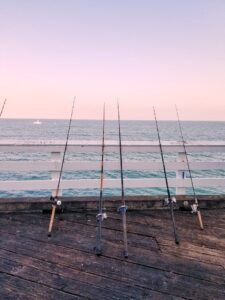
Fishing Rods
Fishing rods are the backbone of your angling experience. They are shipped in numerous sorts, lengths, and materials, every designed for a particular fishing situation:
- Spinning Rods: Versatile and beginner-friendly, spinning rods are great for numerous fish species. They pair with spinning reels and are recognized for their ease of use.
- Baitcasting Rods: These rods are favored by skilled anglers for their accuracy and casting distance. They pair with baitcasting reels and are perfect for focusing on bigger fish.
- Fly Rods: Specifically designed for fly fishing, these long, flexible rods are used with fly reels to cast artificial flies to trout, salmon, and different fish species.
- Ice Fishing Rods: Short and durable, ice fishing rods are crafted for use on frozen lakes. They’re normally less than 36 inches long to accommodate ice holes.
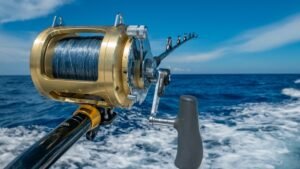
Fishing Reels
Fishing reels are essential for casting and reeling in your catch. There are three main kinds of reels:
- Spinning Reels: Paired with spinning rods, these reels are user-friendly and suitable for novices. They work properly for varied fishing strategies.
- Baitcasting Reels: Commonly used with baitcasting rods, these reels offer better casting precision however require extra skill to make use of successfully.
- Fly Reels: Designed for fly fishing, these reels store and launch the fly line. They’ve a easy design, as the casting effort mainly relies on the angler’s talent.

Fishing Line
Choosing the best fishing line is essential, as it connects you to your catch. Three primary types of fishing lines are available:
- Monofilament Line: A flexible alternative for newbies, monofilament lines are straightforward to handle, provide good knot strength, and have some stretch, which can be helpful when fighting with fishes.
- Fluorocarbon Line: Known for its near-invisibility underwater, fluorocarbon lines are great for conditions where fish are easily spooked. Additionally they have excellent abrasion resistance.
- Braided Line: Braided lines provide excessive strength-to-diameter ratios, making them appropriate for heavy cover fishing and situations where sensitivity and strength are essential.
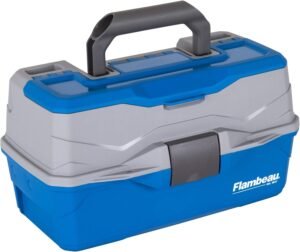
Tackle Box
A container for organizing and carrying your various fishing accessories. A well-organized tackle box ensures you have all the things you need available. Some essentials include:
- Hooks: A wide range of sizes and kinds to match your bait and targeted species.
- Sinkers: Used to add weight to your line, sinkers aid your bait or lure get to the needed depth.
- Swivels: These prevent line twist and allow for simple attachment of leaders and rigs.
- Bobbers or Floats: Used to droop bait at a particular depth or signal when a fish bites.
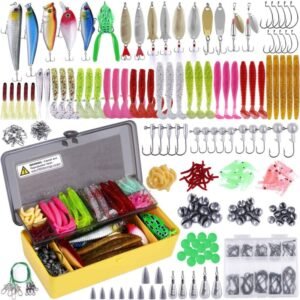
Köder und Köder
A live bait, synthetic lures, or flies are used to entice fish. The choice depends on the species you’re after. Baits and lures are used to entice fish to nip. They come in varied types:
- Live Bait: This contains worms, minnows, and bugs. Live bait is enticing to fish and can be highly efficient.
- Synthetic Lures: This mimic prey, such as fish or bugs, and are available in varied shapes and colors. They can be utilized for a wide range of species.
- Fly Patterns: Fly fishing depends on carefully crafted artificial flies to imitate aquatic bugs or other food sources for fish.

Fishing Hooks
Hooks come in numerous sizes, shapes, and designs, adapted to the kind of bait and fish you are targeting.
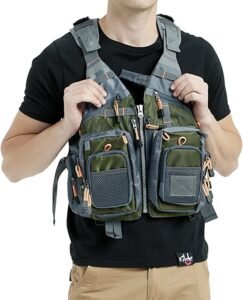
Fishing Vest
Gives room pockets and storage for quick entry to gear and bait.
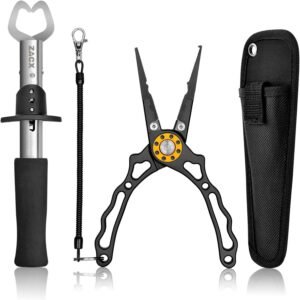
Fishing Pliers
Handy for removing hooks, slicing line, and dealing with fish safely.
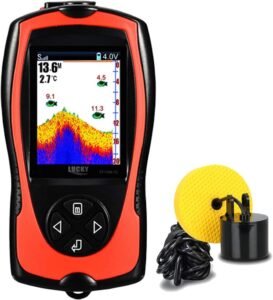
Fischfinder
Electronic devices that provide help in finding fish underwater, perfect for professional anglers in search of precision.
Fishing Fundamentals
Selecting the Right Fishing Location
Choosing the best fishing location is essential to your success as an angler. Listed here are some key things to consider:
Ponds and Lakes
Excellent for beginners because of their calm waters and numerous fish populations. Frequent catches include bass, bluegill, and catfish.
Rivers and Streams
These flowing waters provide challenges and rewards. Trout, salmon, and smallmouth bass are often found here.
Oceans and Coastal Areas
For these in search of bigger adventures, saltwater fishing gives opportunities to catch marlin, tuna, and snapper.
Seasonal and Climate Concerns
Fish Behavior Vary In Various Seasons
- Spring: Fish become energetic as water temperatures rise. This is a great time for spawning species like bass and trout.
- Summer time: Fish are sometimes present in deeper, cooler waters. Early mornings and evenings are prime instances for fishing.
- Fall: As temperatures cool, fish tend to be more energetic once more. It’s a good time to catch a variety of species.
- Winter: Fish tend to be much less active in chilly water. Ice fishing is a well-liked winter pursuit.
Fishing Ethics and Regulations
Responsible fishing includes adhering to ethical and legal standards:
- Catch and Return: A conservation principle in which you release caught fish again into the water, particularly for threatened or endangered species.
- Fishing Licenses: Many regions require fishing licenses, which assist fund conservation efforts and regulate angler numbers.
- Catch Limits: Laws usually specify the quantity and size of fish you can preserve. Respect these limits to help maintain wholesome fish populations.
The Significance of Checking Weather Forecasts
Weather performs a significant role in fishing success. Hold these elements in thoughts:
- Temperature: Fish are sensitive to temperature adjustments. They could move to different depths or areas to search out their most well-liked conditions.
- Wind: Wind can have an effect on casting accuracy and the motion of your bait. Calm days are sometimes greatest for newbies.
- Barometric Pressure: Some anglers believe that fish are extra active when pressure is steady. However, it is just one in all many elements to think about.
Types of Fish Species
- Game Fish: Wanted for sport and challenge, recreational fish contain species like bass, trout, and pike.
- Panfish: Smaller fish like bluegill and crappie are good for newcomers because of their abundance and ease of catching.
- Saltwater Species: These include marlin, tuna, and snapper, offering bigger and more challenging targets.
Some Common Fishing Terms and Jargon
As you enter into the world of fishing, you may encounter some terminologies such as:
- Tackle: Refers to equipment used for fishing, including rods, reels, and lines.
- Tackle Box: A container for storing and organizing fishing gear.
- Landing Net: A net used to help in lifting fish caught from the water.
- Baitcaster: A kind of fishing reel that requires exact casting techniques.
- Lunker: Slang for an enormous fish, sometimes used to describe a prized catch.
- Hookset: The action of setting the hook firmly into the fish’s mouth when it bites.
Getting ready for Your First Fishing Trip
Before heading out on your first fishing adventure, it’s essential to prepare correctly. Here, we’ll be providing you with the essential steps to ensure you have a successful and pleasing experience
Deciding on Appropriate Clothes and Footwear
Selecting the best clothing and footwear is important for convenience and safety:
- Clothes: Put on light-weight, breathable, and moisture-wicking clothes, especially on scorching days. In cooler climate, layer up for heat. Do not forget a hat and sun shades for sun protection.
- Footwear: Go for comfy, waterproof, and supportive shoes or boots with good traction. They need to keep your feet dry and supply stability on uneven terrain.
Packing Fishing Necessities
Before you head to your fishing spot, be sure you have the following necessities packed:
- Fishing Tackle: Your chosen rods, reels, lines, and a choice of hooks, sinkers, and swivels.
- Baits and Lures: Dependent on your desired species and location, carry quite a lot of baits, lures, and flies.
- Fishing License: Make sure you’ve the required fishing license or permits for the area you’ll be fishing at. This is needed to keep away from legal issues.
- Food and Water: Ensure to stay hydrated and full of energy by packing snacks and enough water for your adventure.
- Sunscreen and Insect Repellent: Defend yourself from the sun’s rays and pesky bugs.
- Tackle Box: Ensure to keep your tackle organized in a tackle box with compartments for easy access.
- First Aid Kit: Include basic supplies for minor accidents akin to cuts, scrapes, and bug bites.
- Navigation Devices: A map or GPS device to help you find your route and locate good fishing spots.
Safety Precautions For Fishing
Safety needs to be a high priority during your fishing adventure:
- Sonnenschutz: Apply sunscreen generously to uncovered skin, put on protecting clothes, and use sunglasses with UV protection to protect your eyes.
- Insect Repellent: Use insect repellent to chase away biting bugs, particularly in areas with a excessive bug population.
- Flüssigkeitszufuhr: Stay hydrated by consuming plenty of water all through your trip, especially on hot days.
- Climate Awareness: Keep an eye on changing weather conditions and be prepared to seek shelter in case of storms.
- Environmental Responsibility: Observe the catch-and-release principle at any time when doable, and get rid of trash properly to guard the environment.
How to Set Up and Assemble Your Fishing Gear
Before you can start fishing, you’ll need to assemble your gear:
- Rod and Reel Setup: Match your rod and reel, making certain they’re appropriate in terms of dimension and type. Attach the reel to the rod securely.
- Line Set up: Thread your fishing line by means of the guides on your rod, beginning from the tip and working in the direction of the reel. Attach it to the reel’s spool using an arbor knot.
- Bait or Lure Attachment: Depending on your choice, connect your bait or lure to the end of your line. This can be performed making use of numerous knots or hooks designed for the goal.
Knot Tying Methods
One of the crucial abilities for any angler is knot tying. The improved clinch knot is a elementary knot used to safeguard hooks, lures, and other Tackles to your fishing line. This is the right way to tie it:
- Pass the line by means of the needle eye of the hook, lure, or swivel.
- Wrap the tag end of the line across the standing line 5-7 instances.
- Thread the tag end back by means of the loop formed near the eye of the hook.
- Moisten the knot with saliva or water and pull both the tag end and the standing line to tighten the knot.
- Trim the surplus tag end near the knot.
Fishing Etiquette and Conservation Principles
While the excitement in fishing lies within the pursuit of the catch, it’s equally important to adhere to rules of etiquette and conservation.
We’ll explore the ethics of angling, responsible handling of fish, the practice of catch and return, Leave No Trace culture, and avenues for involvement in conservation efforts.
Respectful Conduct Towards Fellow Anglers
Respecting fellow anglers creates a harmonious fishing setting:
- Give Space: Give ample room between your self and other anglers to prevent crowding.
- Peace & Quiet : Keep noise ranges to a minimal to avoid disturbing both the fish and the other anglers.
- Cleanliness: Dispose of trash properly and take out what you bring.
- Courtesy: Share info and techniques with others, fostering a sense of community.
Ethical Handling of Fish
Minimizing harm to fish is a fundamental facet of ethical angling:
- Reduce Handling: Handle fish as little as possible, as extreme handling can damage their protective slime layer.
- Moist Hands: Wet your palms before touching a fish to reduce the chances of harming their skin and scales.
- Barbless Hooks: Use barbless hooks to make hook removal simpler and less damaging.
- Use Landing Nets: Gently lift the fish from the water utilizing a landing net keep away from injuring the fish.
- Correct Tools: Carry instruments like pliers and hook removers for secure hook extraction.
Practicing Catch and Release Responsibly
- Use Correct Gear: Equip your self with Tackle appropriate for catch and return, including circle hooks that minimize injury.
- Fast Release: Minimize the time a fish spends out of the water; return it promptly.
- Reviving Fish: If obligatory, gently hold the fish upright in the water to ensure it revives and swims away on its own.
- Adhering to Regulations: Respect catch limits and dimension restrictions set by the local authorities.
Leave No Trace Principles for Fishing
Adhering to leave no-trace principles ensures the preservation of pure ecosystems:
- Plan Ahead: Familiarize yourself with fishing regulations and the particular guidelines of the area you’re fishing in.
- Travel and Camp on Sturdy Surfaces: Stick with established paths and shorelines to avoid damaging fragile habitats.
- Dispose of Waste Appropriately: Pack out all trash and eliminate it in designated receptacles.
- Leave What You Discover: Preserve the environment by not disturbing wildlife or vegetation.
- Minimieren Sie die Auswirkungen von Lagerfeuern: If allowed, use a campfire ring or stove for cooking; otherwise, adhere to the local fire laws.
- Respektieren Sie die Tierwelt: Keep a safe distance from wildlife and keep away from feeding them.
- Be Thoughtful of Other Visitors: Keep noise levels down and respect the solitude of others enjoying the outdoors.
Great Tips for Fishing in Different Environments
Fishing environments vary, so adapt your strategy accordingly:
- Shore Fishing: Cast from the shoreline or banks. Look for structures like rocks, vegetation, or submerged logs where fish could take cover.
- Boat Fishing: Use a boat to access deeper water. Trolling and anchoring close to underwater structures can be efficient.
- Kayak Fishing: Kayaks provide mobility and access to shallow waters. Anchor or drift and cast close to submerged structures.
- Ice Fishing: Bundle up for cold climate. Drill holes in the ice and use moveable shelters to stay comfy.
